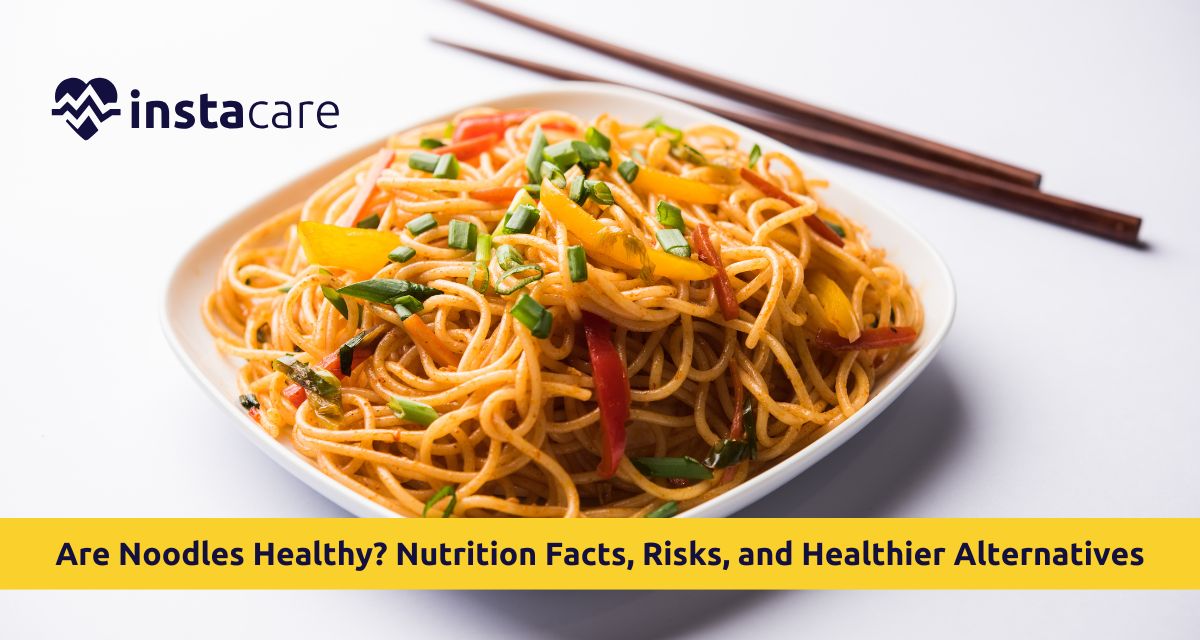Nutritional Profile of Noodles
- Calories in Noodles: 1 cooked noodles (slightly more than approximately 160g) will have approximately 200–220 calories in noodles depending on the type of noodles.
- Carbohydrates: All noodles are carbohydrates and would have 40–50 grams of carbohydrates per serving. Noodles have simple carbohydrates present in huge quantities, particularly the processed ones.
- Protein: Noodles would have 4–8 grams of protein per serving based on the kind of noodles. Egg noodles and soba noodles would have more.
- Fats: are noodles fattening? Traditional noodles have zero fat except for instant noodles, and even they will have 10–15 grams of fats per serving since they already include fried form included.
- Sodium in noodles: Instant noodles specifically have very high sodium contents, some of them have 800–1,500mg of sodium per serving, i.e., more than half a day.
- Fiber: Buckwheat or whole wheat noodles can be taken even when fiber in a serving is 3–5 grams. Refine flour noodles have no fiber.
- Micronutrients: Noodles have B vitamins and iron, but noodles have no vitamins and minerals otherwise.
Health Hazards of Regular Intake of Noodles
- Weight Gain and Obesity: There are surplus quantities of fat and carbohydrate in instant noodles, and regular consumption of instant noodles leads to weight gain. The blood sugar level increases suddenly because of the surplus quantity of carbohydrates, and instant noodles easily deposit into the body in the form of fat.
- Excess Sodium: High blood pressure, heart disease, and kidney disease are caused by an excess amount of sodium. Noodles have an excess amount of sodium and MSG.
- Poor Diet Quality: Noodles do not contain fiber, vitamin, or protein. They are deficient because of one-way dependence.
- Metabolic Syndrome Risk Increase: Regular (on two or more days a week) consumption of instant noodle was related to metabolic syndrome risk, especially in women, in a journal published by Journal of Nutrition. Central obesity, elevated blood glucose level, and cholesterol increase are sign and symptom.
- Gastrointestinal Symptoms: Instant noodles have poor digestibility and will cause constipation or bloat.
- Chemical Preservatives and Additives: Instant noodles are mostly chemical preservatives and additives, and so they, in turn, later will prove to be harmful or already will have been accumulating in the body over the long term.
Are There Any Health Positives?
- Soft source of energy: Noodles contain very high carbohydrate content, which is a soft source of energy. It is ideally suited for sportsmen or for people who prefer instant replenishment of energy.
- easily available and cost-effective: Noodles are shoestring-food and cost-effective.
- Nutrient-Free Base Food: The noodles are already pre-cooked long in advance as a base and nutrients such as vegetables, lean protein, and fats can be added on top.
- Whole Grain Veggie Noodles: More fiber, vitamin, and mineral content in comparison to the regular variety. They are brown rice noodles, quinoa noodles, or zucchini noodles (zoodles).
Read More: Is Chicken Noodle Soup Good for Diarrhea?
Healthier Noodle Options
- Whole Wheat Noodles: Higher proportion of the fiber content, thus fuller for longer and easier digestion too. whole wheat noodles benefits is that it also reduce glycemic index compared to white noodles.
- Rice Noodles: are rice noodles healthy? HORRIBLE digestability but gluten-free and comparatively higher carbs.
- Soba Noodles (Buckwheat): Soba noodles contain high fiber, protein, and mineral content such as manganese and magnesium.
- Shirataki Noodles: Produced from konjac yam, very low caloric and carb. Great low carb noodles diet.
- Zoodles (Zucchini Noodles): The paleo and keto favorite, zoodles are spiral-cut from zucchinis. Low cal, high vitamin C.
- Chickpea or Lentil-Based Pasta: Increased plant protein and fiber and reduced glycemic load.
- Quinoa Noodles: Very protein-dense, gluten-free, rich in magnesium and iron.
Healthy Noodle Cooking Tips
- Add Vegetables: Add some amount of some highly colored vegetable like bell peppers, mushrooms, carrots, broccoli, and spinach for fiber content and nutrients.
- Add Lean Protein: Include grilled chicken, tofu, shrimp, boiled egg, or edamame in the food for nutrition and well-being.
- Avoid the Flavor Packet: The flavor packet has too much sodium and coloring agents found in instant noodles. Avoid and add a few dashes of low-sodium soy sauce, garlic, ginger, herbs, or homemade broth.
- Control Serving Sizes: A minimum serving of 1 cup cooked. Eat it in servings as a challenge to prevent overeating.
- Use Boiling Instead Of Frying: Boiling is an absolute no-no for noodles. Gentle boiling or stir-frying with sesame oil or olive oil.
- Use Whole Grain or Protein Noodles: Intelligent supermarket shopping with intelligent noodle buying.
- Don't Have Them Too Frequently: Relish instant noodles as an exception but never the rule of your life.
- Read Labels: Opt for low-sodium, trans-fat-free, and made-with-whole-ingrediants ones.
Conclusion

